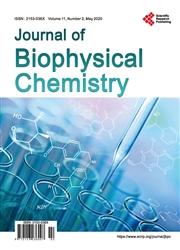Recent enhancement of the immunity in AIDS and other immunocompromised patients by hyperforin an antibiotic from Hypericum perforatum L. (in vitro model) part I
引用次数: 7
Abstract
Today, Hypericum perforatum L. is probably one of the best-characterized medicinal plants, and hyperforin is its best-characterized constituent. Extracts from H. perforatum are widely used as antidepressants; however, less attention has been given to other properties of hyperforin, such as antitumor, fungicidal, antiviral and antibacterial action, or its possible use as a substance with immunomodulation properties. The present study summarizes results that describe the influence of hyperforin as an immunomodulation agent on phagocytosis and the breakdown of Escherichia coli by human polymorphonuclear neutrophils (PMNs). Hyperforin at 1 - 100 μg/mL concentrations was found to have a major influence on phagocytosis and the breakdown of E. coli by PMNs in vitro. A 100 μg/mL solution of hyperforin increased the uptake of non-opsonized E. coli almost 50-fold, and the uptake of IgG-opsonized E. coli more than threefold; on the other hand, the uptake of serum-opsonized bacteria was reduced to approximately 60% of that of the control. Hyperforin seems to bind to both PMNs and E. coli and acts like an opsonin. The elimination of remnants of IgG-opsonized E. coli from the PMNs was stimulated by hyperforin, while the elimination of remnants from non-op-so nized and serum-opsonized material was unaffected by the drug. Hyperforin exhibited clear immunomodulation ability as a phagocytosisstimulating agent. Hyperforin is probably inactive against human immunodeficiency virus (HIV) and most Gram-negative bacteria. However, it can protect acquired immunodeficiency syndrome (AIDS) patients and other immunocompromised patients by its antibacterial activity against Gram-positive bacteria and by enhancement of phagocytosis of Gram-positive and Gram-negative bacteria; some Gram-negative bacteria, such as Neisseria, are sensitive to hyperforin. Hyperforin has the ability to penetrate the blood-brain barrier (BBB) and blood-testis barrier (BTB) and is a valuable antibacterial agent against meningitis and gonorrhea. These properties of hyperforin are important for an antibiotic with immunomodulation activity in the struggle against the growing mortality in AIDS patients as a result of opportunistic bacteria, as recently shown by Bekondi et al. (2006, Int. J. Infect. Dis. 10, 387-395). It could also help to combat primary and opportunistic pathogens associated with meningitis in adults' relation to HIV serostatus.从贯叶连翘(Hypericum perforatum L.)中提取的抗生素贯叶连翘素(Hypericum perforatum L.)对艾滋病和其他免疫功能低下患者的近期免疫增强作用(体外模型)
贯叶连翘(Hypericum perforatum L.)可能是当今最具特征的药用植物之一,而贯叶连翘素是其最具特征的成分。贯叶连翘提取物被广泛用作抗抑郁药;然而,对hyperhyperin的其他特性,如抗肿瘤、杀真菌、抗病毒和抗菌作用,或其作为一种具有免疫调节特性的物质的可能性的关注较少。本研究总结了作为一种免疫调节剂对人多形核中性粒细胞(PMNs)吞噬和分解大肠杆菌的影响。研究发现,1 ~ 100 μg/mL浓度的hyperperin对PMNs体外吞噬和分解大肠杆菌有重要影响。100 μg/mL的hyperperforin溶液使非调理大肠杆菌的摄取增加了近50倍,使igg调理大肠杆菌的摄取增加了3倍以上;另一方面,血清调理菌的摄取减少到对照组的约60%。hyperperin似乎与pmn和大肠杆菌结合,并像调理素一样起作用。hyperperin刺激PMNs中IgG-opsonized的残余大肠杆菌的消除,而非oponized和血清opsonized的残余物质的消除不受药物的影响。hyperperin作为一种促吞噬剂表现出明显的免疫调节能力。hyperperin可能对人类免疫缺陷病毒(HIV)和大多数革兰氏阴性细菌没有活性。然而,它对革兰氏阳性菌的抑菌活性和增强革兰氏阳性菌和革兰氏阴性菌的吞噬作用,可以保护获得性免疫缺陷综合征(AIDS)患者和其他免疫功能低下患者;一些革兰氏阴性菌,如奈瑟菌,对超穿孔素敏感。hyperperin具有穿透血脑屏障(BBB)和血睾丸屏障(BTB)的能力,是抗脑膜炎和淋病的宝贵抗菌剂。正如Bekondi等人(2006,Int.)最近所表明的那样,hyperperin的这些特性对于具有免疫调节活性的抗生素在与机会性细菌导致的艾滋病患者死亡率上升的斗争中是重要的。j .感染。生物学报,10,387-395)。它还可以帮助对抗与成人脑膜炎相关的原发性和机会性病原体与艾滋病毒血清状态的关系。
本文章由计算机程序翻译,如有差异,请以英文原文为准。
求助全文
约1分钟内获得全文
求助全文

 求助内容:
求助内容: 应助结果提醒方式:
应助结果提醒方式:


